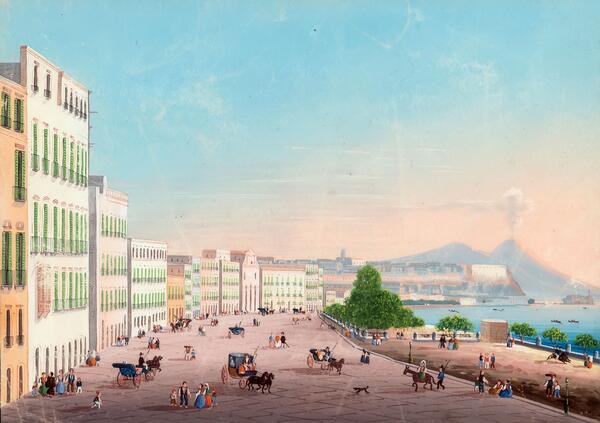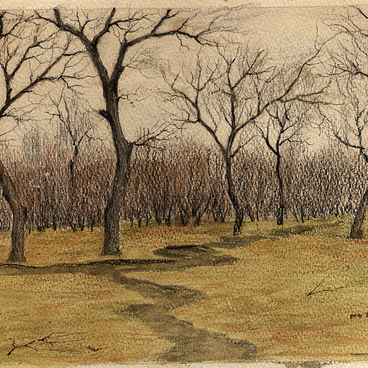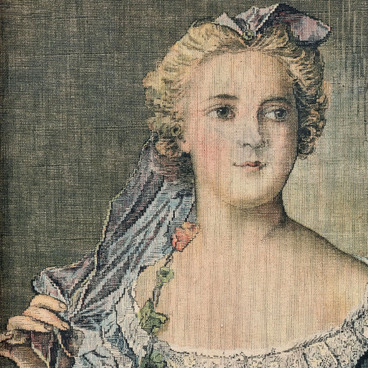The painting ‘Riviera di Chiaia’ depicts one of the central sea-front promenades of Naples. The Volcano Vesuvius, which often dominates Neapolitan landscapes, plays the role of a symbol of the city and its main attraction, is seen in the distance. Another attraction that can be seen in the background is Castel dell’ovo. It is located on the small island of Santa Lucia. The church of Saint Joseph is also seen in a string of urban buildings.
This work belongs to veduta genre. This was the name given to bright graphic sheets depicting everyday urban landscapes or architectural monuments. Usually, such drawings were created by local artists for tourists. Travelers have always wanted to take something as a souvenir back from other countries, and the creations of local artists have satisfied this need. Not surprisingly, such works were produced en masse long before the photograph appeared. Some painters painted urban sketches, others painted architecture, and others painted landscapes. Vedutas can be rightfully considered the precursors of today’s postcards with urban views.
The genre scenes in the foreground attract attention in this work. There are jaunting cars, groups of ladies and gentlemen walking along the promenade, children with parents, a lady on a donkey with a man accompanying her, monks, street traders and delivery men.
Boratynskiy purchased this veduta during his stay in Naples in 1844 as a gift to his family and friends. In one of the letters, the poet mentions Chiaia promenade: ‘Every day, twice, in the morning and in the evening, we go to the beautiful bay, feast our eyes and cannot get enough of it. Chiaia boulevard has so many statues that the Italian moon and the Italian sun light up for us. I understand the artists who need Italy. Here, only here, can a drawing or painting artist be formed’.
After the sudden death of Boratynskiy in Naples on July 11, 1844, his wife Anastasia told her mother-in-law in one of her letters: ‘I would like, my dear mother, to indulge you, and with this intention I am sending you the latest three poems… You will receive simultaneously with them gouache paintings of the Naples outskirts, which Evgeny has chosen for you upon arrival’.
This work belongs to veduta genre. This was the name given to bright graphic sheets depicting everyday urban landscapes or architectural monuments. Usually, such drawings were created by local artists for tourists. Travelers have always wanted to take something as a souvenir back from other countries, and the creations of local artists have satisfied this need. Not surprisingly, such works were produced en masse long before the photograph appeared. Some painters painted urban sketches, others painted architecture, and others painted landscapes. Vedutas can be rightfully considered the precursors of today’s postcards with urban views.
The genre scenes in the foreground attract attention in this work. There are jaunting cars, groups of ladies and gentlemen walking along the promenade, children with parents, a lady on a donkey with a man accompanying her, monks, street traders and delivery men.
Boratynskiy purchased this veduta during his stay in Naples in 1844 as a gift to his family and friends. In one of the letters, the poet mentions Chiaia promenade: ‘Every day, twice, in the morning and in the evening, we go to the beautiful bay, feast our eyes and cannot get enough of it. Chiaia boulevard has so many statues that the Italian moon and the Italian sun light up for us. I understand the artists who need Italy. Here, only here, can a drawing or painting artist be formed’.
After the sudden death of Boratynskiy in Naples on July 11, 1844, his wife Anastasia told her mother-in-law in one of her letters: ‘I would like, my dear mother, to indulge you, and with this intention I am sending you the latest three poems… You will receive simultaneously with them gouache paintings of the Naples outskirts, which Evgeny has chosen for you upon arrival’.



